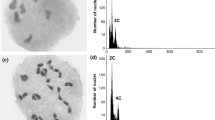Summary
Parthenogenetic seed induction was performed on one clone of Solanum tuberosum subspecies andigena (2n=4x=48) using S. phureja (2n=2x=24) marker inducer clones. The parthenogenetic population when grown was found to contain both diploid and tetraploid individuals presumably arising from reduced and unreduced gametes, respectively. Variation patterns in the diploid and tetraploid sub-populations, as well as a population obtained by selfing the parental clone, were compared to try and elucidate the origin of the tetraploid parthenotes. From the results of this one generation it appeared that the tetraploid parthenogenetic plants had been produced by a mechanism equivalent to second division restitution (SDR).
Similar content being viewed by others
Literature
Dodds, K.S., Long, D.H.: The inheritance of colour in diploid potatoes. I. Types of anthocyanins and their gene loci. J. Genet. 53, 136–49 (1955)
Dodds, K.S.; Long, D.H.: The inheritance of colour in diploid potatoes. II. A three factor linkage group. J. Genet. 54, 27–41 (1956)
Dodds, K.S.; Paxman, G.J.: The genetic system of cultivated diploid potatoes. Evolution 16(2), 154–67 (1962)
Fogwill, M.: Differences in crossing-over size in sex cells of Lilium and Fritillaria. Chromosoma 9, 493–504 (1958)
Frandsen, N.O.: The plastid number as a character in potatoes (in German). Theor. Appl. Genet. 38, 153–67 (1968)
Hanneman, R.E.; Peloquin, S.J.: Ploidy levels of progeny in diploid-tetraploid crosses in the potato. Am. Bot. J. 45, 255–61 (1968)
Harborne, J.B.: The chromatographic identification of anthocyanin pigments. J. Chromat. 1, 473–488 (1958)
Harborne, J.B.: Plant polyphenols — I. Anthocyanin production in the cultivated potato. Biochem. J. 74, 262–9 (1960)
Harborne, J.B.: Comparative biochemistry of the flavonoids. New York & London: Acad. Press 1967
Hermsen, J.G.Th.; Verdenius, J.: Selection from Solanum tuberosum group phureja of genotypes combining high frequency haploid induction with homozygosity for embryo spot. Euphytica 22, 244–59 (1973)
Hougas, R.W.; Peloquin, S.J.; Gabert, A.C.: Effect of seed parent and pollinator on frequency of haploids in S. tuberosum. Crop Sci. 4, 593–5 (1964)
Howard, H.W.: Potato cytology and genetics. 1952–1954. Bibliogr. genet. 19, 87–216 (1960)
Howard, H.W.: Genetics of the potato. Logos Press Ltd. 1970
Howard, H.W.: Calyx forms in dihaploids in relation to the origin of Solanum tuberosum. Pot. Res. 16, 43–6 (1973)
Kawakami, K.; Matsubayashi, M.: Studies on the haploid plants of Solanum tuberosum. I. Morphological characteristics of the polyhaploid plants. Ikushugaku Zasshi/Jap. J. Breeding 10, 10–8 (1960)
Marks, G.E.: An aceto-carmine glycerol jelly for use in pollen fertility counts. Stain Technol. 24, 177 (1954)
Mok, D.W.S.; Peloquin, S.J.: Origin of 2n eggs in phureja-haploid tuberosum hybrids. Am. Pot. J. 52, 281 (abstract) (1975)
Peloquin, S.J.; Hougas, R.W.: Genetic variation among haploids of the common potato. Am. Pot. J. 37, 289–97 (1960)
Ramanna, M.S.: The origin of unreduced microspores due to aberrant cytokinesis in the meiocytes of potato and its genetic significance. Euphytica 23, 20–30 (1974)
Rose, H.; Langton, F.A.: Origin of unreduced embryosacs in diploid potatoes. Nature 247, 378–9 (1974)
Swaminathan, M.S.; Howard, H.W.: The cytology and genetics of the potato (Solanum tuberosum) and related species. Bibliogr. Genet. 16, 1–192 (1953)
Vosa, C.G.: Two track heredity. Differentiation of male and female meiosis in Tulbaghia. Caryologia 25, 275–281 (1972)
Walker, R.J.: Cytological and embryological studies in Solanum, section Tuberarium. Bull Torrey Bot Club 82, 87–101 (1955)
Woodcock, K.M.; Howard, H.W.: Calyx types in Solanum tuberosum dihaploids, S. stenotomum, S. sparsipilum and their hybrids. Pot. Res. 18, 460–5 (1975)
Author information
Authors and Affiliations
Additional information
Communicated by H.F. Linskens
Rights and permissions
About this article
Cite this article
Taylor, L.M. Variation patterns of parthenogenetic plants derived from “unreduced” embryo-sacs of Solanum tuberosum subspecies andigena (Juz. et Buk.) Hawkes. Theoret. Appl. Genetics 52, 241–249 (1978). https://doi.org/10.1007/BF00303500
Received:
Issue Date:
DOI: https://doi.org/10.1007/BF00303500




